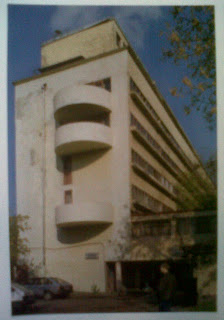Who knows me, knows that I think a lot. It’s obviously that everybody thinks... but some people has this ability (or disability, who knows?) when dealing with a though to consider every single aspect of it. For example... If I am going out, I would be thinking: should I wear a heavy jumper? But then the tube will be too hot. Ok, I am wearing two layers, so I can take one off at the tube. But then, how will a carry it? Should I take a larger bag then? Does it fit the clothes that I am wearing? I don’t have a proper bag. Ok, I am carrying the second layer with my hands. Will I have enough space when I get to sit in the university room? Will I bother other people with the amount of space that I am occupying? Will I... Ok, I will stop here because you are probably starting to think that I am a freak and I sometimes do too (and I just mentioned the issues about a jumper. Imagine talking to me about something as abstract and complex as love). So, that’s me... I think too much!
Sometime ago I was in this crazy puzzle: How to get out of this? How to think a little bit less? You know, it’s pretty damn tiring to think so much. Should I go to therapy? But would therapy help me to think about a way to stop thinking so much? That’s crazy! How to not think so much? (Please, don’t answer me to just “stop” because it’s impossible to stop an autonomous mind).
During my life I came to many answers for this personal challenge... but a turning point was when someone pretty smart said: “Just start to act, start to make things”. Really? No plan? But what if... “One thing is to think about what you wanna do, a whole new deal is to actually do it”. But how? When do I start? “No big clue, no big step... small things... small actions... just DO things”.
Since then, I am concentrated (an in action) on that. “Doing” something doesn’t just mean to read or to clean... it means to “put” things out for the world. So instead of engaging in a crazy and idealized dialogue with myself... I start to dialogue with the world (See now what this blog is for?). Everyday I make sure I “throw” some ideas out for the world. The important thing is less to really get an answer. The important thing is that by doing so I stop the crazy cycle...I am not wondering “if”, I am waiting for a real answer (or comments in this case).
But the funniest thing is that objects also talk. So, if people are too busy... let’s make things!!! Last weekend I made vegetables risotto. First I actually had to talk to a human being. Dad needed to tell me the recipe. But then I started to “talk” with the food... Onion and garlic told me that they have the best smell when fried... the carrots told me that they are harder, so they needed to be cooked for longer. The oven told me that I was operating it wrong, food was getting burned. But then the risotto told me how easy-peasy it is... It’s in good shape no matter how unskilled is the cooker. They were not just products of my imagination... those are things that actually have an impact at the world (despite not speaking English). By the end... instead of a “if” thought inside my mind, I had a good smell outside my nose.
I never proper read Descartes, so I will challenge to paraphrase him without knowing much.... But if he “thinks therefore he is”.... well, in my case, I need to make in order to be (a healthy person). Let’s eat!








